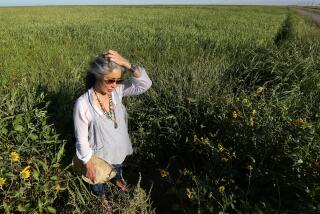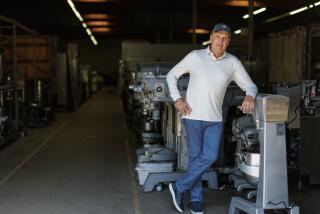Oh, Give Me a Home Where the Buffalo Are Processed : Ranching: North County couple has 80-head herd on spread near Santa Ysabel. Their aim: A meatier, more buffed-out buffalo.
- Share via
Ken Childs is part rancher and part marketer, a man trying to capture consumers with this oldest of made-in-America products.
Buffalo meat. As in buffalo burgers, buffalo steaks, buffalo roast, buffalo chili. As in, forget the beef, where’s the buff?
It’s here, on the 1,000-acre family ranch just outside Santa Ysabel, best known for its bakery and as a stop between Ramona and Julian, that Childs and his wife, Denice, are cookin’ up this campaign that says Americans need to return to the buffalo, now that the buffalo has returned in big numbers to America.
The couple have 400 head of buffalo, most of them on ranches elsewhere but 80 right here in northern San Diego County, where you wouldn’t normally see buffalo roam. (Of course, there’s that wayward herd of buffalo at Camp Pendleton, castoffs from the San Diego Zoo, but they’re just minding their own business and avoiding the tank traffic.)
The Childses breed buffalo to produce meatier, buffed-out buffalo. They sell calves ($1,200) to others smitten with the novelty of having buffalo in their own pastures. They sell buffalo robes ($500 to $800), buffalo head trophies ($1,000 to $2,000) and buffalo skulls ($250 to $500).
But mostly, they raise buffalo to be processed-- please don’t use the word slaughter or butcher , Childs asks --for restaurants and gourmet grocers.
Buffalo is better than beef, he says, and nutrition experts agree: Buffalo meat is less fatty, has less cholesterol than even fish or chicken, and is chock-full of proteins.
Childs says he’s been approached by hospital dietitians and other health-conscious food directors who have talked about contracting with him as a buffalo meat source.
For now, Childs is working to build consumer interest in his grass- and grain-fed buffalo, saying he hopes one day to be the nation’s single largest distributor of it.
He’s negotiating with a Southern California grocery chain to start stocking the meat racks of its upper-end stores with buffalo sirloins and ground buffalo.
Already, Star B buffalo meat is offered at a variety of markets and restaurants from San Diego to Los Angeles.
“People love it, and I haven’t had a single complaint,” boasted Marcus Demian, owner of Buffalo Joe’s in San Diego’s Gaslamp Quarter. His menu features buffalo stew, buffalo burgers and buffalo chili.
Demian figures that, for every two traditional hamburgers he serves up, someone orders a buffalo burger.
Mike Hubbard, manager of the butcher section of the Boney’s market in Vista, said ground buffalo is a relatively popular item because of its low fat content, but that buffalo steaks seem relegated to barbecues where the host wants to impress guests with the novelty of what’s on the grill.
One of the problems in selling buffalo meat, Hubbard and others say, is the cost of it.
Ground buffalo at his Vista store sells for $3.98 a pound--barely enough to cover his own cost for it. By contrast, he sells regular ground beef for $1.79 to $2.29 a pound. Buffalo steaks cost two to three times as much as beef steaks.
“I get maybe 10 customers a week wondering about buffalo steaks,” Childs said. How do you cook it? Because there’s such low fat content, marinate it overnight for juiciness, then barbecue it quickly over a hot fire and take it off medium-rare, he says. How does it taste? The meat has a strong, robust, beefy flavor, he says. Others suggest it tastes sweeter than beef. Some people say it tastes delightfully gamy, which might be an oxymoron.
“The biggest problem with buffalo meat is the price,” Hubbard said. “I don’t make any money on it. I carry it as a novelty item and hope I cover my expenses.”
The regular customers, Hubbard said, are people like his father who enjoy red meat but can’t tolerate the fattier content of beef.
Ken and Denice Childs figure theirs is one of about 1,200 buffalo herds in the nation, numbering 120,000 head in all. Most are on private ranches, and last year 12,000 buffalo were slaughtered--oops, processed--for their meat, he figures.
The notion of commercially grown and harvested buffalo may still cause discomfort to those who hark back to the buffalo’s pained history. The American bison numbered 60 million in 1800, but the animal was hunted nearly to extinction by 1900, when the American Bison Society was established to promote the species’ preservation.
Ken Childs had only a passing romantic interest in buffalo until he and Denice married 20 years ago. His father-in-law, Herbert Boeckmann, a San Fernando Valley auto dealer and land investor, purchased the 1,050-acre ranch near Santa Ysabel in 1978 and looked to his daughter and Ken, a former tool distributor living in Lompoc, to manage it.
“We thought about raising horses, but I’m not an expert on that,” Childs said. “We looked into exotic animals--ostriches, emus and the like--and one day, when the family was sitting out here on the porch and drinking a few beers, my father-in-law suggested we bring in a few buffalo.
“It had all the elements we were looking for: something different, and with a market. It seemed to be a natural for health-conscious Southern California,” he said.
In 1979, Ken and Denice visited a buffalo ranch in South Dakota, worked with the ranch hands, “and we were hooked,” he said. They bought some animals and trucked them to the family ranch.
There, they reinforced fences, built corrals and squeeze chutes, and talked to other buffalo experts around the country who were quick to share the do’s and don’ts of the business. The Childses learned about pinkeye and parasites and grain mixtures and buffalo pregnancies, and that there’s virtually no such thing as a friendly buffalo, and that bull buffalo are only good for one thing.
About 10 years ago, they offered their most docile buffalo for display at the Del Mar Fair and were overwhelmed with questions: Where can we buy buffalo meat?
“Then it really clicked that there was a market for us,” Childs said.
Slowly developing the herd through breeding and more purchases, the Childses figure they’ve now processed more than 100,000 pounds of buffalo meat. The business doubled last year alone, outgrowing the capacity first of a nearby Ramona butcher and, later, a Los Angeles butcher. Today, most of the buffalo meat is processed in Colorado Springs and shipped here, ready for market.
The meat is inspected by the U.S. Department of Agriculture, not because it’s required by law since it’s considered a game animal, but because grocers and restaurants demand it, he said.
This year, the couple hope to triple their buffalo meat sales and are looking to enter the mail-order business.
Ken Childs says he understands the reluctance of people to try buffalo meat.
“Until we had the ranch,” he said, “I hadn’t tried it, either.”
More to Read
Sign up for Essential California
The most important California stories and recommendations in your inbox every morning.
You may occasionally receive promotional content from the Los Angeles Times.










